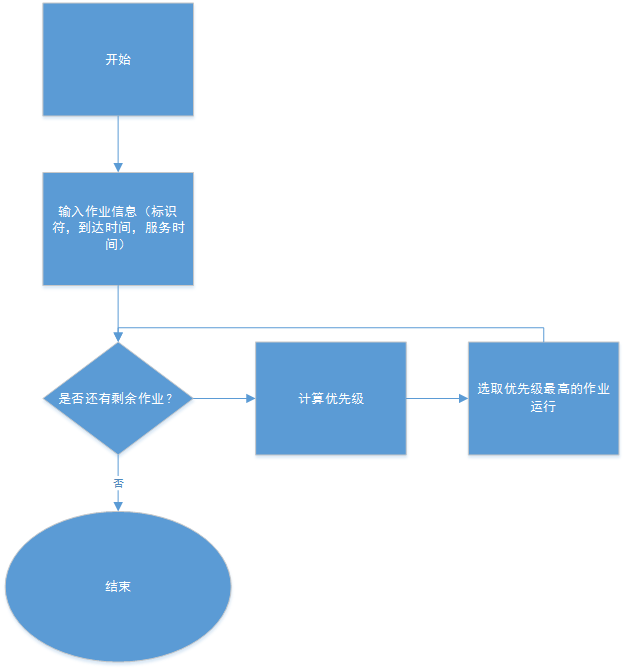BOOM,困到不行,这个写完就睡觉了,今天好像有点感冒 ,翘了晚上的课一直睡到10点起来,睡不着在写代码,现在又困了
高响应比算法,是一种动态调整优先级的算法,在上面介绍的PSA算法中,给每个作业安排一个优先级后,始终这个优先级不再改变,这有些不合理。
因为可能造成一个低优先级作业始终得不到执行。
为了解决这个问题,HRRN算法每次都计算作业的优先级,随着作业等待时间的变长,优先级不断的提高,所以能够得到更快的执行。
这个优先级可以描述为: 优先级 = (作业已等待时间 + 作业的服务时间) / 作业的服务时间
从上式可以看到,作业的服务时间是固定的, 优先级随着已等待时间的提高而变大
//main.cpp
#include "HRRN.h"
int main()
{
std::vector<PCB> PCBList;
//输入作业信息
InputPCB(PCBList);
//HRRN算法
HRRN(PCBList);
//显示结果
show(PCBList);
return 0;
}
//HRRN.h
#ifndef HRRN_H_
#define HRRN_H_
#include <iostream>
#include <algorithm>
#include <iomanip>
#include <vector>
//作业结构体
typedef struct PCB
{
int ID; //标识符
double Level; //优先级
int ComeTime; //到达时间
int ServerTime; //服务时间
int FinishTime; //完成时间
int TurnoverTime; //周转时间
double WeightedTurnoverTime; //带权周转时间
}PCB;
/*
函数功能:输入作业信息
参数说明:
PCBList std::vector<PCB>& PCB链
*/
void InputPCB(std::vector<PCB> &PCBList);
/*
函数功能:HRRN算法
参数说明:
PCBList std::vector<PCB>& PCB链
*/
void HRRN(std::vector<PCB> &PCBList);
/*
函数功能:计算优先级
参数说明:
b std::vector<PCB>::iterator 起始位置
e std::vector<PCB>::iterator 结束位置
CurTime int 当前时间
*/
void CalPriority(std::vector<PCB>::iterator b, std::vector<PCB>::iterator e, int CurTime);
/*
函数功能:显示结果
参数说明:
PCBList std::vector<PCB>& PCB链
*/
void show(std::vector<PCB> &PCBList);
/*
函数功能:比较函数,用于sort(),按ComeTime升序排列
参数说明:
p1 const PCB& PCB
p2 const PCB& PCB
*/
bool CmpByComeTime(const PCB &p1, const PCB &p2);
/*
函数功能:比较函数,用于sort(),按Level降序排列
参数说明:
p1 const PCB& PCB
p2 const PCB& PCB
*/
bool CmpByLevel(const PCB &p1, const PCB &p2);
#endif
//HRRN.cpp
#include "HRRN.h"
//输入作业信息
void InputPCB(std::vector<PCB> &PCBList)
{
do {
PCB temp;
std::cout << "输入标识符: ";
std::cin >> temp.ID;
std::cout << "输入到达时间: ";
std::cin >> temp.ComeTime;
std::cout << "输入服务时间: ";
std::cin >> temp.ServerTime;
PCBList.push_back(temp);
std::cout << "继续输入?Y/N: ";
char ans;
std::cin >> ans;
if ('Y' == ans || 'y' == ans)
continue;
else
break;
} while (true);
}
//HRRN算法
void HRRN(std::vector<PCB> &PCBList)
{
std::sort(PCBList.begin(), PCBList.end(), CmpByComeTime); //按到达时间排序
//同时到达的按优先级降序排序,决定首先运行的作业
int i = 1;
std::vector<PCB>::iterator it = PCBList.begin() + 1;
while ((*it).ComeTime == (*(it - 1)).ComeTime)
{
++i;
++it;
}
CalPriority(PCBList.begin(), PCBList.begin() + i, 0); //计算优先级
std::sort(PCBList.begin(), PCBList.begin() + i, CmpByLevel);
int FinishTime = -1;
for (it = PCBList.begin(); it < PCBList.end(); ++it)
{
if ((*it).ComeTime >= FinishTime) //没有作业正在运行,取队首作业运行
(*it).FinishTime = (*it).ComeTime + (*it).ServerTime;
else //有作业正在运行,等待作业完毕,此作业再运行
(*it).FinishTime = FinishTime + (*it).ServerTime;
(*it).TurnoverTime = (*it).FinishTime - (*it).ComeTime;
(*it).WeightedTurnoverTime = (double)(*it).TurnoverTime / (*it).ServerTime;
FinishTime = (*it).FinishTime;
//在一个作业运行期间,如果有其他作业到达,将他们按照优先级降序排列
i = 1;
while ((it + i) < PCBList.end() && (*(it + i)).ComeTime <= FinishTime)
++i;
CalPriority(it + 1, it + i, FinishTime);
std::sort(it + 1, it + i, CmpByLevel);
}
std::sort(PCBList.begin(), PCBList.end(), CmpByComeTime); //重新排列,用于显示结果
}
//计算优先级
void CalPriority(std::vector<PCB>::iterator b, std::vector<PCB>::iterator e, int CurTime)
{
while (b < e)
{
(*b).Level = (double)((*b).ServerTime + (CurTime - (*b).ComeTime)) / (*b).ServerTime;
++b;
}
}
//显示结果
void show(std::vector<PCB> &PCBList)
{
int SumTurnoverTime = 0;
double SumWeightedTurnoverTime = 0;
std::cout.setf(std::ios::left);
std::cout << std::setw(20) << "标识符";
for (std::vector<PCB>::iterator it = PCBList.begin(); it < PCBList.end(); ++it)
std::cout << std::setw(5) << (*it).ID;
std::cout << std::endl;
std::cout << std::setw(20) << "到达时间";
for (std::vector<PCB>::iterator it = PCBList.begin(); it < PCBList.end(); ++it)
std::cout << std::setw(5) << (*it).ComeTime;
std::cout << std::endl;
std::cout << std::setw(20) << "服务时间";
for (std::vector<PCB>::iterator it = PCBList.begin(); it < PCBList.end(); ++it)
std::cout << std::setw(5) << (*it).ServerTime;
std::cout << std::endl;
std::cout << std::setw(20) << "完成时间";
for (std::vector<PCB>::iterator it = PCBList.begin(); it < PCBList.end(); ++it)
std::cout << std::setw(5) << (*it).FinishTime;
std::cout << std::endl;
std::cout << std::setw(20) << "周转时间";
for (std::vector<PCB>::iterator it = PCBList.begin(); it < PCBList.end(); ++it)
{
std::cout << std::setw(5) << (*it).TurnoverTime;
SumTurnoverTime += (*it).TurnoverTime;;
}
std::cout << std::endl;
std::cout << std::setw(20) << "带权周转时间";
for (std::vector<PCB>::iterator it = PCBList.begin(); it < PCBList.end(); ++it)
{
std::cout << std::setw(5) << (*it).WeightedTurnoverTime;
SumWeightedTurnoverTime += (*it).WeightedTurnoverTime;;
}
std::cout << std::endl;
std::cout << "平均周转时间: " << (double)SumTurnoverTime / PCBList.size() << std::endl;
std::cout << "平均带权周转时间: " << SumWeightedTurnoverTime / PCBList.size() << std::endl;
}
//比较函数,按ComeTime升序排列
bool CmpByComeTime(const PCB &p1, const PCB &p2)
{
return p1.ComeTime < p2.ComeTime;
}
//比较函数,按Level降序排列
bool CmpByLevel(const PCB &p1, const PCB &p2)
{
return p1.Level > p2.Level;
}






















 1130
1130

 被折叠的 条评论
为什么被折叠?
被折叠的 条评论
为什么被折叠?








